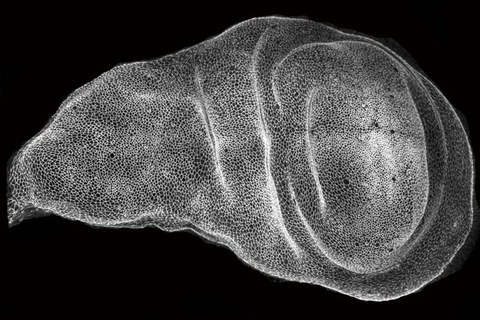09.11.2018
05. November 2018 UNSER PAPER ÜBER DIE REGULATION VON KRÄFTEN BEI DER FALTUNG VON GEWEBEN WURDE IN NATURE COMMUNICATIONS PUBLIZIERT.
Differential lateral and basal tension drive folding of Drosophila wing discs through two distinct mechanisms
Liyuan Sui1*, Silvanus Alt2,3,8*, Martin Weigert4,5, Natalie Dye5, Suzanne Eaton5,6, Florian Jug4,5, Eugene W. Myers4,5,7, Frank Jülicher2,4, Guillaume Salbreux2,3 and Christian Dahmann1
1 Institute of Genetics, Technische Universität Dresden, 01062 Dresden, Germany 2 Max Planck Institute for the Physics of Complex Systems, Nöthnitzer Strasse 38, 01187 Dresden, Germany 3 The Francis Crick Institute, 1 Midland Road, NW1 1AT, London, UK 4 Center for Systems Biology Dresden (CSBD), Pfotenhauerstrasse 108, 01307 Dresden, Germany 5 Max Planck Institute of Molecular Cell Biology and Genetics, Pfotenhauerstrasse 108, 01307 Dresden, Germany 6 Biotechnologisches Zentrum, Technische Universität Dresden, Tatzberg 47/49, 01309 Dresden, Germany 7 Department of Computer Science, Technische Universität Dresden, 01062 Dresden, Germany 8 Present address: Max-Delbrück-Center for Molecular Medicine, Robert-Rössle-Strasse 10, 13125 Berlin, Germany * Equal contributions
Epithelial folding transforms simple sheets of cells into complex three-dimensional tissues and organs during animal development. Epithelial folding has mainly been attributed to mechanical forces generated by an apically localized actomyosin network, however, contributions of forces generated at basal and lateral cell surfaces remain largely unknown. Here we show that a local decrease of basal tension and an increased lateral tension, but not apical constriction, drive the formation of two neighboring folds in developing Drosophila wing imaginal discs. Spatially-defined reduction of extracellular matrix density results in local decrease of basal tension in the first fold; fluctuations in F-actin lead to increased lateral tension in the second fold. Simulations using a 3D vertex model show that the two distinct mechanisms can drive epithelial folding. Our combination of lateral and basal tension measurements with a mechanical tissue model reveals how simple modulations of surface and edge tension drive complex three-dimensional morphological changes.
Die TU Dresden hat zu unserem Paper eine Presseinformation veröffentlicht:Link

